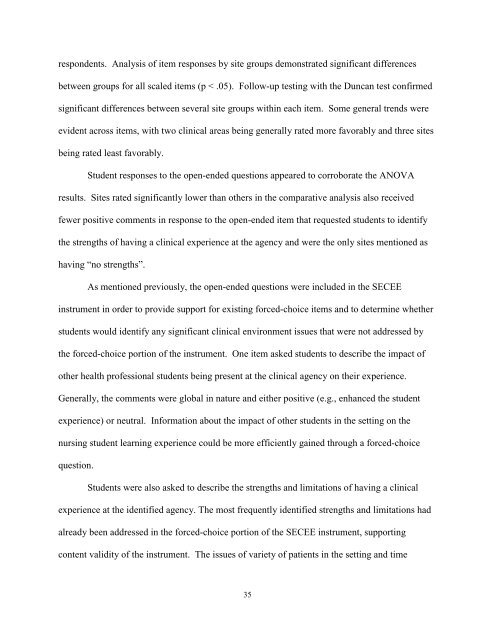STUDENT EVALUATION OF CLINICAL EDUCATION ENVIRONMENT
STUDENT EVALUATION OF CLINICAL EDUCATION ENVIRONMENT
STUDENT EVALUATION OF CLINICAL EDUCATION ENVIRONMENT
Create successful ePaper yourself
Turn your PDF publications into a flip-book with our unique Google optimized e-Paper software.
espondents. Analysis of item responses by site groups demonstrated significant differences<br />
between groups for all scaled items (p < .05). Follow-up testing with the Duncan test confirmed<br />
significant differences between several site groups within each item. Some general trends were<br />
evident across items, with two clinical areas being generally rated more favorably and three sites<br />
being rated least favorably.<br />
Student responses to the open-ended questions appeared to corroborate the ANOVA<br />
results. Sites rated significantly lower than others in the comparative analysis also received<br />
fewer positive comments in response to the open-ended item that requested students to identify<br />
the strengths of having a clinical experience at the agency and were the only sites mentioned as<br />
having “no strengths”.<br />
As mentioned previously, the open-ended questions were included in the SECEE<br />
instrument in order to provide support for existing forced-choice items and to determine whether<br />
students would identify any significant clinical environment issues that were not addressed by<br />
the forced-choice portion of the instrument. One item asked students to describe the impact of<br />
other health professional students being present at the clinical agency on their experience.<br />
Generally, the comments were global in nature and either positive (e.g., enhanced the student<br />
experience) or neutral. Information about the impact of other students in the setting on the<br />
nursing student learning experience could be more efficiently gained through a forced-choice<br />
question.<br />
Students were also asked to describe the strengths and limitations of having a clinical<br />
experience at the identified agency. The most frequently identified strengths and limitations had<br />
already been addressed in the forced-choice portion of the SECEE instrument, supporting<br />
content validity of the instrument. The issues of variety of patients in the setting and time<br />
35












